Pointers and References
Steven Zeil
In this lesson, we examine the data types that C++ provides for storing addresses of data.
These are important because they
-
Allow access to objects created “on the fly” (dynamic storage allocation)
-
Permit access to “large” objects without copying
-
Allow selective access to parts of large structure
1 Indirection
-
Pointers and references allow us to add a layer of “indirection” to our data.
-
Instead of giving an answer directly, we give the location where the answer can be found.
It’s rather like answering a question about, say, the meaning of the word “Ragnarok” by pointing to a nearby dictionary instead of explaining it directly.
In our code, sometimes we will employ this indirection for efficiency. In other cases we use it for flexibility or to simplify our code.
A pointer or reference is the “name” or “address” of an object NOT the object itself.
Most variables have names assigned to them by the programmer at the time the program is written (e.g. “int numberOfCourses;”). Every variable in a program has an machine address where that variable is stored in the main memory of the computer. Think of this as the “machine’s name” for the variable.
Every variable in a program has a value which is the data stored in the variable’s address.
2 References
Reference types are introduced by the use of “&” in a type expression.
- Reference types hold the address of an already existing data value
Example
double z[1000]; ⋮ int k = i + 200*j; double& zk = z[k];zk holds the address of z[k].
Initializing References
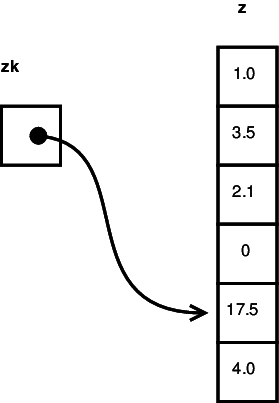 When reference variables are declared, they must be immediately initialized to the location of some existing data value, e.g.,
When reference variables are declared, they must be immediately initialized to the location of some existing data value, e.g.,
double& zk = z[k]; // zk get address of z[k]
One initialized, a reference cannot be reset to point to a different location
Accessing data Via References
 One initialized, we can use the reference much like any ordinary variable:
One initialized, we can use the reference much like any ordinary variable:
double& zk = z[k]; // zk get address of z[k]
cout << zk; // accesses data stored
// at that location
Assignment and References
Subsequent assignments to a reference variable will store new values at that location, but will not change the location.
double& zk = z[k]; // zk get address of z[k]
zk = 1.0; // changes the value of z[k]
++k;
zk = 2.0; // changes the value of z[k-1]
Example: working with indirection
Question: What would the output of the following code be?
int a = 1;
int b = a;
cout << a << " " << b << endl;
a = 2;
cout << a << " " << b << endl;
b = 3;
cout << a << " " << b << endl;
Example: working with indirection (cont.)
Let’s make a one-character change …
Question: What would the output of the following code be?
int a = 1;
int& b = a;
cout << a << " " << b << endl;
a = 2;
cout << a << " " << b << endl;
b = 3;
cout << a << " " << b << endl;
References and Loops
Once initialized, a reference cannot be reset to a different location.
- However, if we declare a reference within a loop body:
for (int i = 0; i < 100; ++i) { int k = longAndComplicatedCalculation(i); double& zk = z[k]; doSomethingWith (zk); }Then each time around the loop we are initializing a different reference variable
-
Variables that are declared inside a
{}are destroyed when we reach the closing}. -
So, each time around the loop, zk refers to a different element of the array.
-
The above example suggests one reason why we may use references – to avoid repeating long and complicated calculations to select array elements or struct members.
Const References
When we modify a reference type by pre-pending “const”:
-
We are allowed to look at the data value whose address is stored in the reference.
-
But we cannot alter the data value via that reference
Money price (24, 95); Money& salePrice = price; const Money& oldPrice = price; price.dollars = 25; // OK salePrice.dollars = 26; // OK oldPrice.cents = 0; // illegal, cannot change value -
Note that both of the legal assignments would affect the values seen in all three variables.
References and Functions
You’ve seen lots of functions using reference parameters
void foo (Money& m, const Time& t);
-
We’ve explained in the past that this was “pass by reference”, a special parameter passing mechanism.
-
In fact, as far as the compiler is concerned, there is no special parameter passing mechanism.
- This is still “pass by copy”.
- But the type of data being copied and passed are references
- All the “special” behavior associated with reference parameters stems from the normal properties of references
- Passes addresses instead of actual data
- Allows alteration of data back in the caller …
- Unless the reference type is marked
const, in which case we can “look but not touch”.
References and Functions (returns)
References are also sometimes used as return types
const Money& getAmountBid (Bid& b)
{
return b.amountBid;
}
⋮
cout << getAmountBid(myBid).dollars;
Slight improvement in efficiency – the Money value does not need to be copied.
References and Functions (returns) cont.
Money& getAmountBid (Bid& b)
{
return b.amountBid;
}
⋮
getAmountBid(myBid).dollars = 0;
3 Pointers
Pointers
Pointers, like references, store the location or address of data.
-
Pointers relax many of the restrictions on references
- Pointers need not be initialized when declared (a bad idea)
- When initialized, they need not hold an address of existing data
- can be null instead
- After initialization, they can be reassigned to refer to a different data element.
-
But pointers lose some of the convenience of references:
- Require special syntax to access the data referred to by a pointer
3.1 Working with Pointers
Declaring Pointer Variables
A pointer declared like this
double *p;
contains, essentially, random bits.
To be useful, it must be initialized
double *p = ...
or, later, re-assigned
p = ...
Initializing Pointer Variables
Where do new pointer values come from?
-
Pointers can be given the addresses stored in other pointers:
int* q = ... ⋮ int* p = q;- But that doesn’t really answer the question. It just defers it.
-
Pointers can be assigned the address of an existing data value via the
&operator:int a = 23; int *p = &a;- But this is rare, dangerous, and generally frowned upon
-
Pointers can be given the address of newly allocated data:
int *p = new int; int *pa = new int[100]; -
Pointers can be set to null, a special value indicating that it does not point to any real data.
There are multiple ways to do this:
-
“0” is a null pointer
int *p = 0;- That’s not zero. It’s a null pointer.
-
NULL is a special symbol declared in
<cstdlib>#include <cstdlib> ⋮ int* p = NULL; -
Coming soon, courtesy of the new C++11 standard
int *p = nullptr;
-
NULL is actually a bit of a problem. Not only do you have to include a special header to get it, but there are some rare circumstances where passing it to functions that take a pointer as parameter will not compile properly. Hence the new standard introduced a better-behaved universal null pointer constant.
This won’t be available, however, until compilers take the C++11 features out of their beta status.
Dereferencing a Pointer
Accessing data whose address is stored in a pointer is called dereferencing the pointer.
- The unary operator
*provides access to the data whose location is stored in a pointer:Money *p = new Money(100, 25); ⋮ Money m = *p; // * gets the whole data element *p = Money(0,15); // and we can store there
Dereferencing and Structs
- The operator
->provides access to struct members via a pointer:Money *p = new Money(100, 25); ⋮ int totalCents = 100*p->dollars + p->cents; p->dollars = 0;- These two statements are equivalent:
p->dollars = 0; (*p).dollars = 0;
- These two statements are equivalent:
Assignment and Pointers
Subsequent assignments to a pointer variable will change the location it points to.
double* zk = &(z[k]); // zk get address of z[k]
*zk = 1.0; // changes the value of z[k]
zk = &(z[k+1]);
zk = 2.0; // changes the value of z[k+1]
Example: working with pointers
Question: What would the output of the following code be?
int a = 1;
int b = 2;
int* pa = &a;
int* pb = &b;
cout << a << " " << *pa << " " << b << endl;
a = 3;
cout << a << " " << *pa << " " << b << endl;
*pb = 4;
cout << a << " " << *pa << " " << b << endl;
pa = pb;
cout << a << " " << *pa << " " << b << endl;
Const Pointers
When we modify a pointer type by pre-pending “const”:
-
We are allowed to look at the data value whose address is stored in the reference.
-
But we cannot alter the data value via that reference
Money price (24, 95); Money* salePrice = &price; const Money* oldPrice = salePrice; price.dollars = 25; // OK salePrice->dollars = 26; // OK oldPrice->cents = 0; // illegal, cannot change value -
Same as the affect of
conston references
3.1.1 Memory and C++ Programs
Where is data Stored?
The memory of a running C++ program is divided into three main areas:
-
The static area holds variables that have a single fixed address for the lifetime of the execution.
- Variables declared outside of any enclosing
{}or
marked asstatic.
- Variables declared outside of any enclosing
-
The runtime stack (a.k.a. activation stack or automatic storage) has a block of storage for each function that has been called but from which we have not yet returned.
- All copy parameters and local variables for the function are stored in that block.
- The block is created when we enter the function body
- and destroyed when we leave the body.
-
The heap is a programmer-controlled “scratch pad” where we can store variables
- But the programmer has the responsibility for managing data stored there
How Functions Work
int foo(int a, int b)
{
return a+b-1;
}
would compile into a block of code equivalent to
stack[1] = stack[3] + stack[2] - 1;
jump to address in stack[0]
The Runtime Stack
-
the “stack” is the runtime stack (a.k.a. the activation stack) used to track function calls at the system level,
-
stack[0] is the top value on the stack,
-
stack[1] the value just under that one, and so on.
An Example of Function Activation
Suppose that we were executing this code, and had just come to the call to resolveAuction within main.
#include "time.h"
void resolveAuction (Item item)
{
⋮
int h = item.auctionEndsAt.getTime();
⋮
}
int main (int argc, char** argv)
{
⋮
resolveAuction (item);
⋮
}
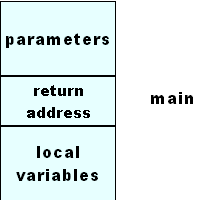
The runtime stack (a.ka., the activation stack) would, at this point in time, contain a single activation record for the main function, as that is the only function currently executing:
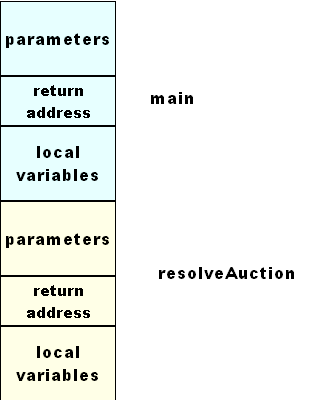
When main calls resolveAuction, a new record is added to the stack with space for all the data required for this new function call.
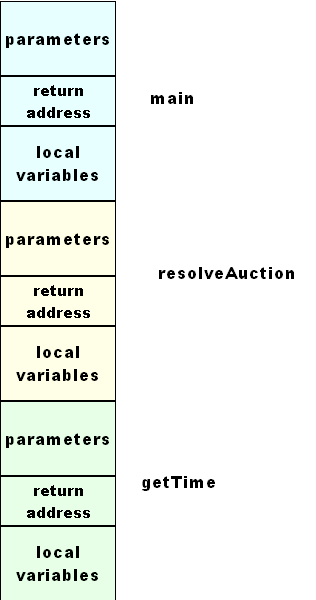 When resolveAuction calls getTime, another new record is added to the stack with space for all the data required for that new function call.
When resolveAuction calls getTime, another new record is added to the stack with space for all the data required for that new function call.

But once getHours returns (to resolveAuction), that activation record is removed from the stack. resolveAuction is once again the active function.
 And when resolveAuction returns, its record is likewise removed from the stack.
And when resolveAuction returns, its record is likewise removed from the stack.
3.1.2 Allocating Data
Example of Overall Memory layout
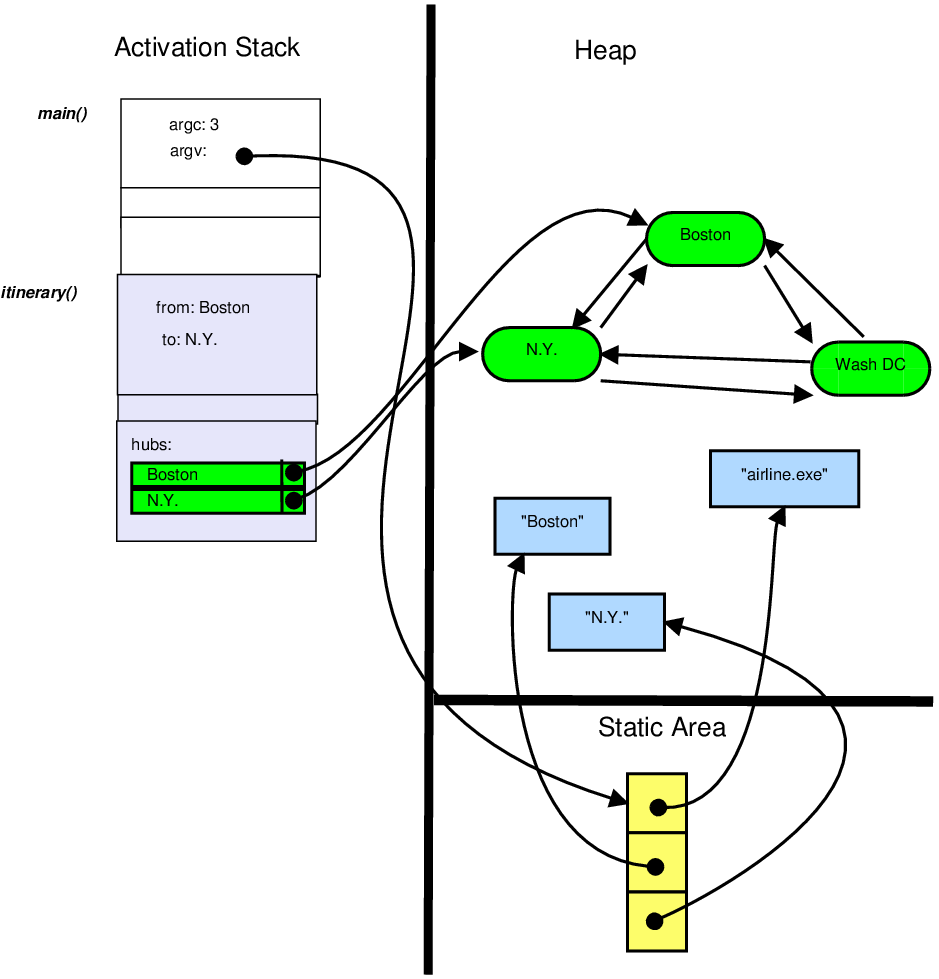
Allocating Data on the Heap
We allocate data with new and remove it with delete:
int *p = new int;
int *pa = new int[100];
⋮
delete p;
delete [] pa;
Note the slightly different forms for arrays versus single instances.
Dynamic Allocation
Programmers often distinguish between “dynamic” and “static” activities:
-
Something is “dynamic” if it happens at run-time, under control of the program.
-
Something is static if it happens at compile-time and/or is controlled by the compiler.
int *p = new int;
int *pa = new int[100];
Allocation of data via new is called dynamic allocation of data.
Dynamically allocated memory is controlled through the two operators new and delete
-
The new operator allocates sufficient memory to store one or more objects of the specified type.
-
The type of the object to be allocated follows the new operator
-
Memory is allocated from the heap.
-
-
The delete operator returns the memory allocated to an object back to the memory pool to be reused.
Summary: Pointers versus References
| References | Pointers | |
| Type Declaration | & |
* |
| Initialization | must be initialized points to existing data |
optional may be null |
| Dereferencing | automatic | *, -> |
| Management | automatic | new, delete |
| Dangerous? | minimal | very |
3.2 Pointers Can Be Dangerous
Because pointers provide access a memory location and because data and executable code exist in memory together, misuses of pointers can lead to both~ bizarre effects and very subtle errors.
Potential Problems with Pointers
-
uninitialized pointers,
-
memory leaks and
- dangling pointers.
Uninitialized pointers
-
Uninitialized pointer pose a significant threat.
-
the value stored in an uninitialized pointer could be randomly pointing anywhere in memory.
-
Storing a value using an uninitialized pointer has the potential to overwrite anything in your program, including your program itself
-
-
Your best defense:
Never write a declaration like
Money* p;Always give your pointers an initial value
Money* p = 0;- Null if you can’t make it point to a real data value.
Memory Leaks
A memory leak occurs when all pointers to a value allocated on the heap has been lost, e.g.,
int isqrt (int i)
{
int* work = new int;
*work = i;
while ((*work) * (*work) > i)
-- (*work);
return *work;
}
-
When we return from this function the local variable work is lost.
- But that has the only copy of the address of the int that we allocated on the heap.
-
Each call to this function will leak a bit of memory.
Over time, memory leaks can cause programs to slow down and, eventually, crash.
Worse, a leaky program may come to take up so much of a systems memory that it interferes with the operation of other programs on the same system.
Dangling Pointers
Dangling pointers refer to a pointer which was pointing at an object that has been deleted.
int* p = new int;
int* q = p;
⋮
delete p;
-
The pointer q still has the address of the object even though the memory for that object has been returned to the system.
-
If the memory allocated to the deleted object is re-used for another purpose,
- The value visible via q may appear to “spontaneously” change
- Storing a value via q may corrupt that other data
4 The Secret World of Pointers
4.1 Pointers and Arrays
What’s in a Name? (of an array)
int a[100];
double b[1000];
-
You know what expressions like
a[i]andb[2]do -
But what about just “
a” or “b”?
Arrays are Pointers
int a[100];
double b[1000];
-
Arrays are really pointers
- a has type
*int - b has type
*double
- a has type
-
They point to the first (
[0]) element.
You may have observed examples of passing arrays to functions as parameters. They are usually passed as pointers. That’s possible because of the fact that arrays really are pointers.
Pointer Arithmetic
- You can add integers to pointers pointerArith.cpp
#include <iostream> using namespace std; int main() { int *i = new int; double *d = new double; cout << "i " << i << " d " << d << endl; i = i + 1; ++d; cout << "i " << i << " d " << d << endl; return 0; }
> g++ pointerArith.cpp
> ./a.out
i 0x1eea010 d 0x1eea030
i 0x1eea014 d 0x1eea038
>
- Actually adds to the address the number of bytes required to store one data value of the type pointed to
Pointer Arithmetic 2
- You can subtract pointers from one another pointerArith2.cpp
#include <iostream> using namespace std; int main() { int array[5]; int* p = &(array[0]); int* q = &(array[3]); cout << "p " << p; cout << " q " << q; cout << " q-p " << (q-p); cout << endl; }
> g++ pointerArith2.cpp
> ./a.out
p 0x7fff2065c380 q 0x7fff2065c38c q-p 3
>
- Computes how many element-sized blocks away from wach other the two addresses are
OK, Why do Pointer Arithmetic?
Pointer arithmetic is actually illegal and pretty much useless except when the addresses are all within a single array.
double b[1000];
-
b is a pointer to the start of the array
-
b[i]is simply a convenient shorthand for*(b+i)
Pointers, Arrays, and Functions
This is why, when arrays are passed to functions, they are generally passed as pointers:
double sumOverArray (double* a, int n)
{
double s = 0.0;
for (int i = 0; i < n; ++i)
s += a[i];
return s;
}
We’ll have more on this shortly when we look at dynamically allocated arrays.
4.2 Pointer and Strings
Not all strings are created equal.
-
In C++’s parent language, C, there is no std::string
-
Strings were stored in character arrays
- End of a string was indicated by a byte containing the ASCII character NUL (value $0$)
-
Less than satisfactory
- NUL is actually a useful character in some contexts
- Many string operations were needlessly slow
-
C++ retains the C string operations for backwards compatibility.
String Literals
The most common place where strings and character arrays meet is in string literals.
-
"abc"does not have type std::string -
Its data type is actually const char*
- And it actually takes up 4 characters, not 3
-
The std::string type provides a constructor
string (const char* charArray);for building new strings from character arrays.
main
The main function in C++ programs has the prototype
int main (int argc, char** argv)
-
argc is the number of command line parameters.
-
argv holds the command line parameters.
Question: Why are there two asterisks in char**?
The first ’*’ indicates that each parameter is a C-style character array (passed, as is common for arrays, as a pointer).
The second ’*’ indicates that this is an array of those character arrays (again, passed as a pointer), because there can be multiple command line parameters.
4.3 Pointers and Member Functions
Hide the Parameter
Remember that when we convert standalone functions to member functions, one parameter becomes implicit:
struct Money {
⋮
};
Money add (Money left, Money right);
becomes
struct Money {
⋮
Money add (Money right);
};
Revealing the Hidden Parameter
That parameter really does exist
-
Its name is “this”
-
Its data type, for any struct S, is
S*
struct Money {
...
Money add (/* Money* this,*/ Money right);
};
Using this
Sometimes we need to make explicit reference to the implicit parameter.
Suppose that we had
Money Money::add (Money right)
{
Money result;
result.dollars = dollars + right.dollars;
result.cents = cents + right.cents;
return result;
}
and wanted to add some debugging output …
Explicit this
Money Money::add (Money right)
{
cerr << "Entering Money::add, adding "
<< *this
<< " to " << right << endl;
Money result;
result.dollars = dollars + right.dollars;
result.cents = cents + right.cents;
return result;
}
There’s really no other way to pass the whole “left” value to another function or operator.
The need to explicitly refer to this is unusual, but not all that rare.

